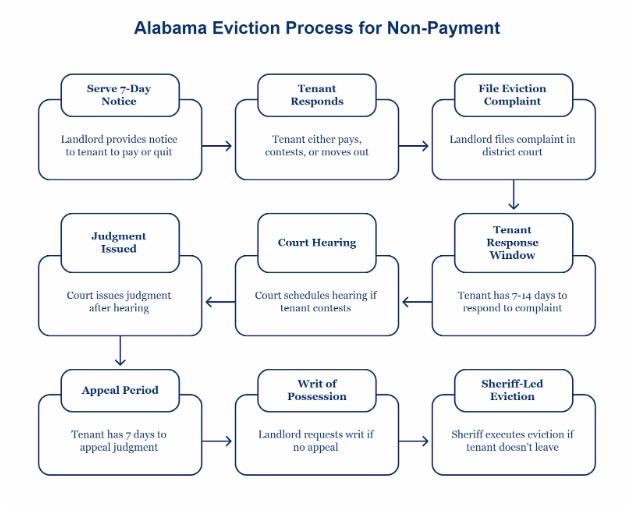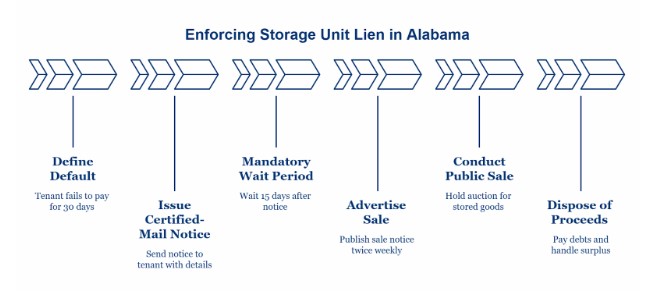
Originally published: July 2025 | Reviewed by J. Wesley Atkinson
Understanding the legal timeline is crucial for Alabama landlords when dealing with tenants who have stopped paying rent.
In Alabama, landlords can initiate the eviction process as soon as rent is overdue by issuing a 7-day notice to the tenant to either pay or vacate the premises.
Taking action quickly can help protect property and avoid delays that cost time and money.
The rules for removing a non-paying tenant must be followed closely to avoid costly mistakes.
Knowing when and how to initiate this process is crucial, as each step has its specific legal requirements. This article outlines the timeline, key steps, and potential pitfalls, providing landlords with practical solutions for addressing these issues based on trusted guidance and real-world examples.
Key Takeaways
- Alabama law allows eviction notices the day after rent is late
- Timely and correct steps help avoid legal and financial problems
- Following the process carefully leads to a smoother resolution
Understanding Alabama’s Eviction Vs. Storage-Lien Process

Landlords in Alabama follow different legal steps to remove tenants compared to storage unit operators reclaiming units for unpaid fees.
For rental properties, the rules stem from landlord-tenant laws, while storage unit situations follow a separate lien process.
Eviction Under Landlord-Tenant Laws (Non‑Residential And Residential Scenarios)
Eviction in Alabama begins with a written notice for nonpayment under Ala—code 35‑9A. For unpaid rent, landlords must issue a 7-day notice to pay or vacate before starting court proceedings.
This applies to both residential leases and most non-residential leases. If rent is unpaid after the notice is served, the landlord can file an eviction lawsuit, which will result in a court hearing.
Tenants have the opportunity to pay during the notice period and may remain if the balance is settled. If they do not pay or move out, and the court rules in favor of the landlord, the tenants must leave within 7 days of the judgment.
After the 7 days, the landlord may remove any personal items left behind, but must wait at least 14 days before disposing of them.
These steps ensure adherence to proper legal procedures and protect tenant rights in both non-residential and residential settings.
Storage‑Unit Lien Process Under Ala. Code Title 8, Chapter 15, Art. 2
The storage lien process in Alabama differs from typical eviction laws. Instead, storage operators use a lien process under Ala. Code Title 8, Chapter 15, Article 2, when a renter fails to pay.
The operator must provide written notice of the overdue payment and intent to sell the contents. This notice gives the tenant at least 14 days to pay and reclaim their property.
If the rent remains unpaid, the facility may hold a public or private auction to sell the stored goods. The proceeds are used to cover unpaid fees, with any remaining money returned to the renter, if claimed.
Access to the unit may be denied once the lien process starts, but no court eviction order is needed. This process is specific to storage units and is a key difference from the Alabama nonpayment eviction process versus a lien for traditional rental properties.
Step‑By‑Step: Initiating Eviction In Alabama For Non‑Payment

Evicting a non-paying tenant in Alabama involves a strict timeline and several legal steps.
Landlords must use the right notices, observe waiting periods, and follow court procedures closely to regain possession of the property lawfully.
Serving A 7‑Day Notice To Pay Or Quit – When And How
For tenants who have not paid rent on time, Alabama law requires the landlord to serve a 7-day notice to pay or quit.
This gives tenants a final, short window to either pay the overdue rent or leave the property.
Rent is due at the start of the month and considered late the day after, unless the lease says otherwise.
The notice must be delivered properly. Landlords usually serve it in person, post it at the unit, or mail it to the tenant. The notice should include:
- The total rent owed
- A clear deadline (7 days from service)
- The option to pay and stay or move out
If the tenant pays all money due within this period, the landlord cannot proceed with the eviction. Failing to serve or incorrectly serving this notice can result in delays later in the eviction process.
Filing The Eviction Complaint In District Court
If the tenant does not pay within 7 days or vacate, the landlord can start the formal eviction process by filing a Complaint for Unlawful Detainer at the local district court.
The landlord should bring proof of the unpaid rent, the lease terms, and a copy of the 7-day notice.
Filing requires:
- A completed complaint form
- Supporting documents
- A filing fee (varies by county)
The court will then issue an official summons for the tenant. This step officially places the matter under the court’s supervision.
Landlords in Alabama must refrain from attempting to remove tenants themselves after this point and should adhere to the court’s schedule for hearings and notices.
Tenant’s Response Window (Possible 7–14 Days)
Once served with court papers, the tenant has a limited time to respond—usually 7 days from the date they receive the summons.
In some cases, the court may allow up to 14 days, especially if service was made by mail or if the tenant requests additional time.
During this period, tenants may:
- Pay the amount due (if still allowed)
- Contest the eviction
- Move out voluntarily
If the tenant answers the complaint, the case proceeds to a hearing. If they do not respond, the landlord may request a default judgment.
The specific response window may depend on how the court summons was served and local district court rules.
Court Hearing, Judgment, And 7‑Day Appeal Period
If the dispute remains unresolved, a court hearing is scheduled. Both parties present evidence, mainly proof of non-payment and proper notice. The judge then issues a judgment, typically within a few days of the hearing.
If the landlord wins, the tenant usually has a 7-day appeal period to contest the ruling. The timeline for an appeal is strict. If the tenant files an appeal within this window, eviction is paused until the higher court reviews the case. Failure to appeal allows the landlord to reclaim the property.
The court’s decision and deadlines must be followed exactly for both the landlord and the tenant to protect their rights under Alabama law.
Issuance Of Writ Of Possession And Sheriff‑Led Eviction – Official Timeline
If the tenant does not appeal within seven days, the landlord may request that the court issue a Writ of Possession. This document orders law enforcement to remove the tenant if they do not leave voluntarily.
Only the sheriff or a court-approved official is authorized to carry out forced removal.
It typically takes a few days after the landlord requests the writ to be issued and served. The sheriff will schedule the physical eviction as soon as possible, sometimes within a week.
The entire process, from notice to possession, usually takes about 3 to 5 weeks, but this timeframe may vary depending on the county’s workload and court schedules.
Landlords should not take the law into their own hands at any stage. Only sheriff-led evictions are legal once the writ is issued.
This ensures the timeline is followed and both parties’ legal rights are protected.
Struggling with missed rent and legal delays? Atkinson Law, P.C. handles Alabama real estate closings with precision, so you can act fast and stay protected. Contact us to secure your timeline.
If you’re ready to get started, call us now!
Step‑By‑Step: Enforcing A Storage Unit Lien In Alabama

Alabama has strict legal steps for storage unit owners dealing with tenants who fail to pay.
Following each stage is vital to protect the owner’s rights and comply with Ala Code Title 8 Chapter 15, and related storage lien laws in Alabama.
Defining Default—30 Continuous Days Late
A tenant is considered in “default” if they do not pay rent or other charges for 30 continuous days. This period starts the day after payment is due under the lease agreement.
After the 30-day mark, the self-storage owner has certain legal rights, including the right to place a lien on the stored goods.
This 30-day benchmark is the minimum period that must pass before any other action can be taken under the Alabama self-storage default 30-day rule. Without this, the storage provider cannot move to the next steps of the legal process.
Issuing Certified‑Mail Notice: Contents And Delivery Rules
When the default is reached, the storage facility owner must send a written notice to the occupant by certified mail.
The law requires the notice to include the total amount owed, provide a brief description of the goods, state that a lien has been placed, and warn that the goods may be sold.
The notice should also explain the time and place of a planned sale if the balance isn’t paid.
According to Alabama storage lien law, the delivery address must be the last known address of the tenant. Proof of mailing is required in case there are disputes later.
Mandatory Wait Period: At Least 15 Days After Notice
After sending the certified mail notice, the owner must wait at least 15 days before moving forward. This period provides the tenant with a final opportunity to settle the debt and reclaim their property.
During these 15 days, no advertisement or public auction can be started. Skipping this waiting stage violates Alabama law and can make lien enforcement actions invalid.
The timing must be tracked carefully as part of the Alabama storage lien timeline.
Advertisement Of Sale: Format, Frequency, And Timing (Pub. Twice Weekly)
If payment is not made in 15 days, the storage facility can begin advertising the sale.
By Alabama law, notice of the sale must be published twice a week for at least two consecutive weeks in a local newspaper located in the area where the facility is situated.
Each ad must include the name of the tenant, the address of the storage facility, and provide details about the time, date, and location of the public sale.
This step is required under Alabama storage lien advertisement rules and provides the public and the tenant with proper notice of the upcoming sale.
Public Sale/Auction: Minimum Days After First Ad, Conduct Rules
The public sale or auction cannot be held until 15 days after the first advertisement runs. The sale must be open to bidders. It should be conducted either at the storage facility or another location mentioned in the notice and ad.
Anyone can bid, except the storage facility owner or its employees. The purpose is to get a fair market value for the goods to cover the amount owed.
Disposition Of Proceeds And Handling Of Surplus Or Unsold Items
After the auction, the storage facility uses the funds to pay off the amount the tenant owed for rent, late fees, and costs associated with enforcing the lien, such as postal or publication fees.
If there is any money left after paying these expenses, the surplus must be given to the tenant. If the tenant cannot be found, the surplus is handled according to state laws, often turned over as unclaimed property.
If the sale does not cover the full debt, the tenant may still be responsible for the remaining balance under Alabama storage tenant rights redemption.
Unsold items may be disposed of in a manner that is reasonable and permitted by law, only after following all required steps and time frames in Alabama. Code Title 8 Chapter 15 Storage Law.
Must‑Know Legal And Practical Pitfalls
Landlords must follow the law carefully to avoid costly setbacks when dealing with non-paying tenants. Simple mistakes can lead to loss of rights or even lawsuits.
Understanding steps such as notice, documentation, and legal differences between eviction and storage liens is essential for a smooth process.
Consequences Of Premature Enforcement—Notice Missteps & Loss Of Lien Rights
Acting before completing required legal steps often leads to serious problems. For example, if a landlord sends an eviction notice before the rent is overdue, the court can dismiss the case.
Skipping or using the wrong type of notice can sometimes mean starting the whole process over, causing delays and further loss of rent.
Lien rights for landlords, such as those dealing with stored property, also have strict timeframes and notice requirements.
If notice isn’t given properly, or action is taken too early, landlords risk losing the right to collect unpaid rent through the sale of the tenant’s belongings. Alabama law requires landlords to carefully follow statutory guidelines for serving notices and adhering to timelines.
Missing key deadlines or acting too soon often results in the loss of important legal protections. It’s important to double-check each notice given and avoid informal shortcuts.
Documentation And Record‑Keeping Best Practices
Keeping detailed records helps protect landlords if tenants challenge an eviction or the sale of stored property.
All notices should be kept, even if sent by email or text. Copies of certified mail receipts, photographs of posted notices, and payment records are also important.
Landlords should use a simple table or checklist for each tenant that tracks:
| Document Type | Date Given | Method Sent |
| Late Notice | 06/01/2025 | Certified Mail |
| Eviction Notice | 06/08/2025 | Posted to the Door |
| Payment History | 04/2025–06/2025 | Digital/Manual |
Accurate documentation can help prove that a landlord followed all legal requirements. In court, these records might be needed to defend against claims of improper action or to explain a timeline.
Tenant Rights: Redemption Periods And Protection From Improper Sale
Tenants have specific rights meant to prevent unfair loss of property or sudden eviction. After an eviction or storage lien notice is served, Alabama law typically provides a “redemption period” during which the tenant can pay the outstanding amount and halt the process.
Trying to remove a tenant or sell stored items before the end of the redemption period is a violation of the law.
Courts often side with tenants if landlords rush this process. In some cases, landlords may be required to return the property or pay damages.
Landlords must communicate timelines and refrain from pressuring tenants to move or pay early. A clear understanding of these rights helps avoid legal problems and promotes fair treatment.
Distinction Between Residential Eviction And Storage‑Lien Laws
Evictions for non-payment and actions taken under storage lien laws are distinct. Residential eviction focuses on regaining possession of a rental unit, while storage-lien laws involve the landlord’s right to hold or sell a tenant’s property for unpaid rent.
The process under the eviction law requires court approval before removing a tenant. Storage lien actions, on the other hand, follow different notice rules and often do not require a court order before selling belongings. Mixing up these legal frameworks creates confusion and risk.
Landlords should confirm which set of rules applies before taking action.
Unclear property records can stall enforcement. Atkinson Law, P.C. delivers title insurance services that clarify ownership and strengthen your legal footing. Contact us to eliminate obstacles before they become a costly issue.
If you’re ready to get started, call us now!
Data‑Backed Insights & Alabama Case Studies
Recent data and case studies provide clear benchmarks for landlords in Alabama. Eviction timelines and legal costs are well-documented, providing property owners with a practical understanding of what to expect before initiating the eviction process for non-paying tenants.
Average Eviction Timelines In Alabama (30–60 Days Typical)
Eviction cases in Alabama usually take between 30 and 60 days from start to finish. The exact timeline depends on court scheduling, response time from tenants, and whether a jury trial is requested.
After a landlord serves the required legal notice—typically a 7-day notice for nonpayment—the case can quickly move to court if the tenant does not pay or vacate. Some counties may have different procedures, but most follow this general timeframe.
A power company case study in Alabama demonstrates that utility providers rely on predictive models to estimate incident durations and required resources, thereby creating more precise timeframes for service restoration after disruptions.
This data-driven approach yields more accurate planning, particularly when delays are possible due to weather or backlogs, thereby enabling landlords to set realistic expectations for their tenants.
Local Legal Costs, Court Fees, And Expense Benchmarks
Court filing fees in Alabama for eviction actions generally range from $250 to $350, depending on the county. Other costs, such as process server fees or legal representation, can add $100 to $500 or more.
Landlords should be aware of the Digitizing Utilities Prize won by Alabama organizations for creating systems that track and predict operational expenses. While this is focused on utilities, it highlights the value of using data analytics to track and manage legal costs across regions, thereby helping to set benchmarks for budgeting and reducing unexpected expenses.
Here’s a quick reference table:
| Expense Category | Typical Range |
| Court Filing Fee | $250 – $350 |
| Process Server | $50 – $100 |
| Attorney Fees | $150 – $500+ |
Pro Tips: Smart, Compliant Execution
Landlords in Alabama must follow strict procedures to remove non-paying tenants. Mistakes in paperwork, notice delivery, or calculating timelines can slow down or stop the eviction process.
Drafting Notices That Stand Legal Scrutiny
A strong eviction notice should follow the Alabama landlord eviction checklist. The notice must have the tenant’s name, address, reason for eviction (such as non-payment), and the amount due. Landlords should use clear language and refrain from making threats or emotional statements.
Alabama requires landlords to give a 7-day notice for unpaid rent. The notice must inform the tenant of the problem and provide them with an opportunity to pay.
It’s a good idea to keep a copy of the notice for records. If the notice is missing key details, courts may reject the eviction case.
Landlords should review sample notices or contact a housing authority to avoid mistakes. Ensuring that every detail aligns with the law’s requirements can prevent delays.
Choosing Certified Mail Vs. In-Person Delivery
In Alabama, landlords often deliver eviction notices by using an Alabama-certified mail service or handing them to the tenant.
Certified mail gives proof that the notice was sent and received. The landlord obtains a receipt to present to the court.
In-person delivery means the landlord hands the notice directly to the tenant or someone of sufficient age at the home.
This can be quicker, but there’s no automatic paper trail. Some courts may want a witness or a photograph as proof.
Certified mail is usually safer and helps when tenants deny receiving the notice. For best results, landlords should use certified mail and keep all receipts. This serves as a record in case of a dispute.
Counting Deadlines Correctly—Calendar Vs. Business Days
Alabama law often counts eviction notice periods using calendar days, including weekends and holidays.
If a 7-day notice is required, it means seven straight days from when the tenant receives the notice, not just business days.
Landlords need to note when delivery occurs and count forward, ensuring they do not file court papers too soon.
If the last day falls on a weekend or holiday when the court is closed, filing the next business day keeps things on track.
Mistiming deadlines is a top reason courts dismiss eviction cases. A calendar or written log helps landlords keep track, so they follow Alabama law closely.
Knowing When To Consult An Attorney
If a landlord is unsure about the wording, delivery, or calculations related to notice timelines, a lawyer can assist.
An attorney can check that the process meets state standards and review the Alabama landlord eviction checklist.
Legal advice is helpful if the tenant contests the eviction, claims the notice was not served correctly, or brings up housing code issues. Courts may also have special local rules.
Attorneys provide guidance that helps avoid small mistakes that could require a landlord to restart the process. When in doubt, consulting a professional can save time and reduce risk.
Conclusion
Landlords in Alabama must follow a specific timeline when handling non-paying tenants. Acting too soon or skipping steps can lead to delays or legal issues.
The steps begin with providing the tenant with a 7-day notice after a missed rent payment has occurred.
If the tenant pays within this period, the process stops. If not, the landlord may file for eviction in court.
The entire process typically takes between four and six weeks, depending on the court’s schedule and whether the tenant contests the case.
Courts may handle each eviction a little differently, so it’s essential to prepare all documents and follow local rules.
Alabama law gives both landlords and tenants certain rights. Being informed and organized helps everyone get through the process more smoothly.
Thinking bigger than just one rental? Atkinson Law, P.C. helps Alabama landlords formalize storage ventures through business formation strategies that scale. Contact us to structure your operation effectively.
Contact Us Today For An Appointment
Frequently Asked Questions
When can a storage facility in Alabama begin the lien process for non-payment?
In Alabama, storage owners can begin the lien process 30 days after a tenant’s missed payment. This is the legal threshold for default under Ala. Code § 8-15-31.
What notice must be given to tenants before a storage unit auction in Alabama?
Alabama law requires storage owners to send a certified mail notice at least 15 days before a sale, detailing the amount owed, item description, and proposed sale date. The notice must comply with Ala. Code § 8-15-33.
How long does it take to evict a non-paying tenant in Alabama?
The eviction process in Alabama typically takes 30 to 60 days, beginning with a 7-day Notice to Pay or Quit, followed by a court filing, a hearing, and a 7-day appeal window if the tenant contests the eviction.
What is the difference between eviction and a storage lien in Alabama?
Eviction applies to residential or commercial rentals under the Alabama Uniform Residential Landlord and Tenant Act. A storage lien applies to self-storage units and follows a separate process under Ala. Code Title 8, Chapter 15.
Do Alabama landlords need a court order to remove a non-paying tenant?
Yes. Landlords must file for eviction in district court, obtain a judgment, and wait for a Writ of Possession before law enforcement can remove a tenant. Self-help evictions are illegal.
Can tenants in Alabama stop a storage auction by paying late?
Yes. Tenants in Alabama have the right to redeem their belongings by paying the full amount owed before the sale occurs, according to Ala. Code § 8-15-34.
What are the advertising requirements for storage auctions in Alabama?
The sale must be publicly advertised in a newspaper of general circulation in the county where the facility is located, with two advertisements published at least seven days apart before the sale.

